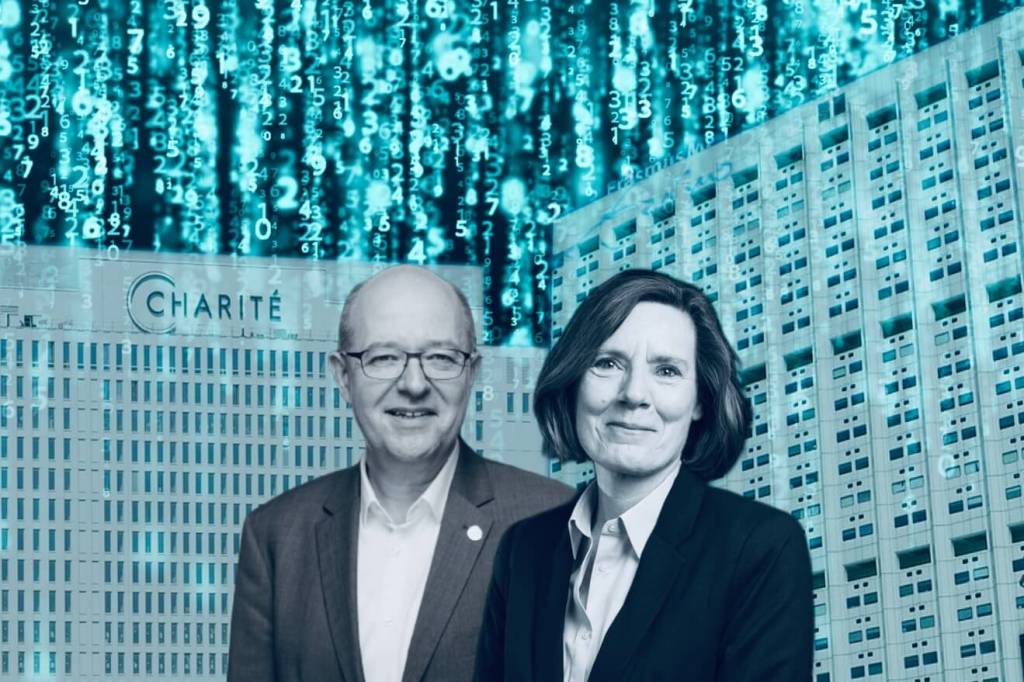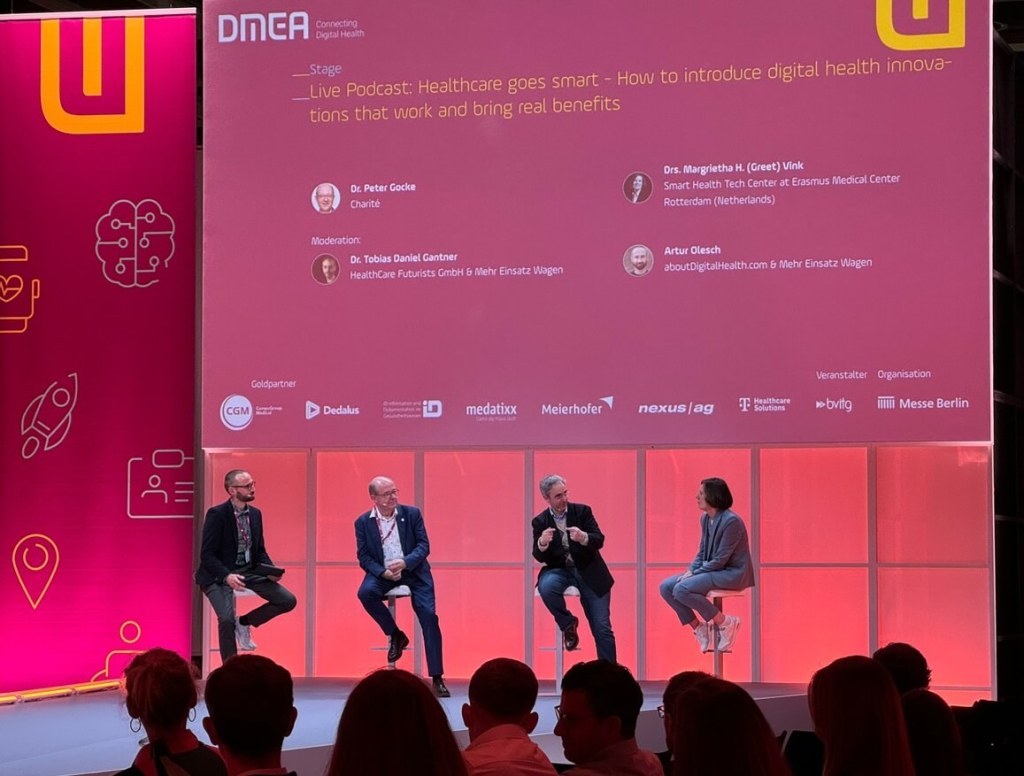
How to navigate digital transformation in healthcare, according to experts from Charité Berlin and Erasmus Medical Center. And why the worst advice ever is to wait for a more superior technology.
At DMEA, the digital health trade fair and congress in Berlin, Margrietha Greet Vink, Director of the Smart Health Tech Center (SHTC) at Erasmus Medical Center, and Peter Gocke, Chief Digital Officer at Charité Berlin, joined on stage for a Live Podcast “Mehr Einsatz Wagen” (“Dare More”).
Moderated by Artur Olesch, a journalist, and Tobias Gantner, CEO of Healthcare Futurists, the 45-minute discussion focused on what healthcare organizations need to do to make innovations thrive, how to implement innovations in real-life settings, and how to strengthen digital maturity.
Farewell from past utopias
“Hospitals should co-create innovations instead of just being passive adopters of solutions developed by technology-driven companies. It’s the reason why what you get doesn’t always fit the clinical settings,” according to Greet Vink. In the SHTC that she leads, startups and tech companies can develop, test, and evaluate their solutions by teaming up with clinicians and patients.
Today, every tech company or startup declares to have a solution for the challenges healthcare facilities face, from down-to-earth ones like the rising administrative burden on healthcare professionals to more generalized issues like uncoordinated care, low workflow efficiency, medical errors, and patient dissatisfaction.
“Too often, we look for nice-looking products. We buy them, hoping their introduction will make everybody happy in the hospital,” Gocke says. This approach worked well in the past in the case of simple applications for reimbursement and administrative tasks. But as we progress to higher levels of digital maturity, complexity rises—hospitals must carefully examine their processes and rethink them before solidifying them with a digital framework.
Who wants to have a hospital at home?
If Charité were a hotel, it would only be a one-star hotel. It excels at providing high-class medical services, but from the patient’s perspective, care is limited to surgery, doctor visits, and treatments—components that are not always prioritized in an already costly system that strains healthcare budgets.
Digitalization can align the divergent goals of patients and payers by streamlining care wherever patients are located. The first contact point with the healthcare system should be digital in order to triage patients and coordinate care efficiently, as well as avoid wasting limited healthcare resources and patients’ time. This shift towards a harmonious coexistence of virtual and physical care—while upholding or even strengthening fundamental values in medicine—is at the core of the Charité 2030 Vision.
Much work must be done to achieve this vision. The checklist includes educating healthcare professionals and patients, fine-tuning legislation to enable data exchange and processing, improving data interoperability, integrating new data points into electronic health records, establishing common data models, investing in infrastructure to ensure widespread digital coverage, and breaking down data silos.
“Good healthcare is data-driven science,” Gocke emphasizes. “Digitalization also addresses another critical aspect we often overlook. In Germany, there are currently around 1,900 hospitals. Some of them may not exist in 20 years. Suppose we do not digitize and centralize data storage. In that case, we risk losing valuable healthcare records forever—creating more black holes in the electronic health records of thousands, if not millions, of patients.”
The art of digitalization lies in the ability to think ahead and extrapolate, leveraging existing means to achieve goals. However, be aware that technologies change rapidly, and those we use today will become obsolete in 10 years. What lasts forever is data.
“We already have a lot of unused data. Consider all these wearables—they do not need to be perfectly accurate. It’s enough if they are accurate enough to provide a hint that there might be a problem requiring attention from a doctor. A prime example is a single-channel ECG used to detect early signs of atrial fibrillation,” explains Greet Vink.
Certain data should be tracked to act as a warning signal for patients, create a feedback loop after treatment, or monitor outcomes as reported by patients (referred to professionally as PROMs—Patient-Reported Outcomes). This data can also fuel large cohort studies aimed at understanding why people fall ill, enabling the early detection of diseases.

Change is never seamless, no matter how we wish it to be
Transformation, paradoxically, often starts with a necessary break to revise existing processes, gain deeper insights overlooked in the daily rush, question cultivated beliefs, and retune an organization. This involves asking subjective questions about the problem and speculating about alternative scenarios to follow the regression to the mean principle—a concept of asking “why” as long as necessary to identify the source of workflow bottlenecks.
If you want to change the culture in a system like a hospital, start with “why.” To make it easier, you can follow Simon Sinek’s principles of the Golden Circle, suggests Gocke:
- Why do we want to do it?
- What do we need to do it?
- How do we do it?
Charité in Berlin is currently undergoing this phase as Europe’s biggest hospital replaces its electronic medical record system.
“Technology is the easiest part. You can simply buy a system that will work. The difficult part begins when you have to change habits and restructure processes. To succeed, you need teamwork so that every stakeholder is on board. It’s not just the job of the IT department because IT specialists are not the end-users of the technology,” Gocke points out. He also highlights another pivotal attribute: sticking to decisions and continuing to rebuild workflows. This is an unpopular job, a sometimes painful process that has nothing to do with the casual understanding of change management as smooth orchestration.
This dirty job of changemakers, however, has a clear goal: to reach a tipping point where the benefits of digital transformation outweigh the efforts. It triggers a shift where healthcare professionals start to complain if processes are still not digitalized. It takes patience and consistency to achieve such a moment of narrative turnaround.
The IT alignment problem and the natural forces of resistance
Change management in a hospital is complex and requires reconciling sometimes competing interests. The IT department is satisfied when the existing Hospital Information System (HIS) runs stably; managers advocate for digitalization to improve workflows and financial turnover, which is then reinvested to enhance patient care. Meanwhile, overburdened healthcare professionals demand easier digital health solutions but often lack the time to learn new IT systems. Is there a way to find a satisfactory compromise for all stakeholders?
Yes, if the hospital manager is a leader who knows how to communicate with people and negotiate change. “At Charité, we have implemented an approach based on clear objectives and key results,” says Gocke. “Our board of directors sets goals and breaks them down for every employee. This way, everyone can get engaged and collaborate on the project. When the implementation phase comes, everyone receives training and retraining.”
Resistance against digitalization is often misunderstood. If people have had bad experiences with existing software, they are likely to harbor negative feelings toward new systems. Unfortunately, this is a side effect of decades of functional but impractical software.
As e-health solutions entered hospitals, doctors had to adapt to the technologies they received. While software developers have improved user experience (UX) and user interface (UI) design, the positive impact has been overshadowed by the increasing time spent with computers. Initially used for billing, then electronic patient records, and now for documenting nearly everything in the name of improving care quality, doctors have gradually grown accustomed to systems they do not prefer. It’s akin to realizing how slow your computer is only when you purchase a new one.
Rather than accepting things as they are—or the technologies available on the market—Erasmus Medical Center took an active approach and created the Smart Health Tech Center (SHTC).
“Hospitals complain a lot, but they do not facilitate getting better technology,” according to Greet Vink. “SHTC acts as a liaison between external technologies and internal needs.” Previously, companies recruited doctors from hospitals; now, it’s the reverse: companies come to the hospital to develop their technologies in clinical settings.
This new paradigm makes sense. Given the complexity of digitalization, we need to engage end-users from the beginning and rethink how knowledge is generated and where software is developed, leaving ample space for experimentation within engineering and medical teams.
Digital transformation in healthcare is an evolving process that must mature alongside the continuous evolution of technologies.
Rapid fire questions
The worst advice you have ever received regarding digital transformation in healthcare.
Wait for a better solution.
The hype right now you don’t want to hear about anymore.
Digitalization and AI.
Technology that fascinated you most recently.
Large Language Models.
Technology that will make electronic health records great again.
Speech as an interface.
What would you do differently if you had a second chance?
Do not focus only on virtual training. People want to have on-site support when adopting a new solution. Discuss every change not only with doctors but also with nurses and other workers.
Would you advise your children to become doctors, nurses, or data scientists?
Data scientist.

Can I ask you a favor?
Please donate to aboutDigitalHealth and support independent journalism. Thank you!
€1.00